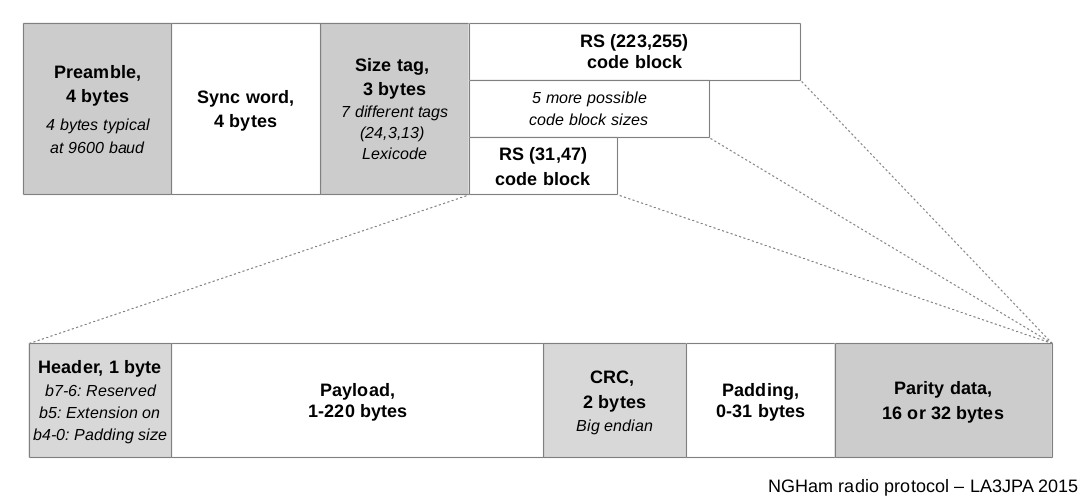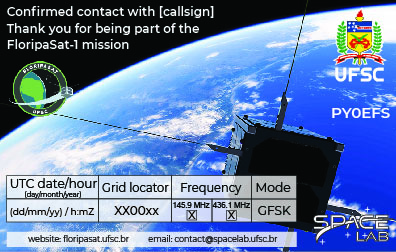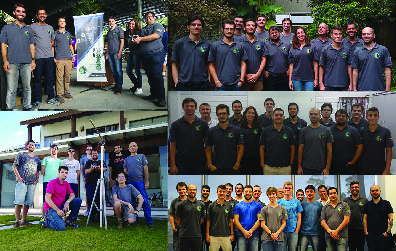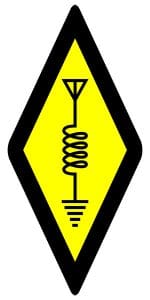INFORMATION FOR COMMUNICATING WITH FLORIPASAT-1
FloripaSat-1 communicates through VHF and UHF bands
Operation and communication Parameters
COMMUNICATION: VHF
Beacon
The beacon is sent periodically and it provides the satellite basic statistics and data.
COMMUNICATION: UHF
Downlink and Uplink
The downlink provides complete satellite packets. The uplink allows telecommands to be received.
OPEN COMMANDS
Repeater
Open to the ham radio community, there are three open commands: ping, data request and message broadcast.
PROTOCOLS
NGHam e AX.25
FloripaSat-I uses two different protocols: NGHam and AX.25. Both for VHF and only NGHam for UHF.
DATA
Decoding
Using the FloripaSat-1 custom-made software, it is possible to process and decode the collected data.
Tracking
Use the following information for tracking:
NORAD ID: 44885
International Designator: 2019-093G
Orbit
Altitude: 628.6km;
Inclination: 97.9°;
Cycle Repetition: 31 days;
Orbit Period: 5835 seconds;
Ascending Node Local Time: 10:30 a.m.
- Frequency: 145.9 MHz
- Protocol: NGHam and AX.25
- Modulation: GFSK
- Deviation: 2.5 kHz
- Baudrate: 1200 bps
- Output Power: 30 dBm (1 W)
The Beacon of FloripaSat-I transmits packets periodically, with 5 possible periods (accordingly to the overall energy level of the satellite):
| Energy Level | Beacon Period [s] |
|---|---|
| L1 (100% – 90% of total battery charge) | 10 |
| L2 (92.5% – 80% of total battery charge) | 10 |
| L3 (82.5% – 70% of total battery charge) | 20 |
| L4 (72.5% – 60% of total battery charge) | 30 |
| L5 (62.5% – 0% of total battery charge) | 30 |
In normal satellite operation, the beacon packets contains the following data:
| Field | Offset | Length [bytes] | Content |
|---|---|---|---|
| Satellite ID | 0 | 10 | “FLORIPASAT” |
| Batteries voltages | 10 | 4 | Variable |
| Batteries tempearatures | 14 | 6 | Variable |
| Total charge of batteries | 20 | 2 | Variable |
| Solar panels currents | 22 | 12 | Variable |
| Solar panels voltages | 34 | 6 | Variable |
| Overall status of the satellite | 40 | 2 | Variable |
| Accelerometer and gyroscope | 42 | 12 | Variable |
| Time since boot | 54 | 4 | Variable |
| Number of OBDH module resets since launch | 58 | 2 | Variable |
If a fault on the OBDH module occurs (if the TTC module stops receiving data from it), only the EPS data are transmitted:
| Field | Offset | Length [bytes] | Content |
|---|---|---|---|
| Satellite ID | 0 | 10 | “FLORIPASAT” |
| Batteries voltages | 10 | 4 | Variable |
| Batteries tempearatures | 14 | 6 | Variable |
| Total charge of batteries | 20 | 2 | Variable |
| Solar panels currents | 22 | 12 | Variable |
| Solar panels voltages | 34 | 6 | Variable |
| Energy level | 40 | 1 | Variable |
If a fault occurs in the OBDH and EPS modules, only the satellite ID is transmitted:
| Field | Offset | Length [bytes] | Content |
|---|---|---|---|
| Satellite ID | 0 | 10 | “FLORIPASAT” |
- Frequency: 436.1 MHz
- Modulation:2- GFSK
- Protocol: NGHam
- Deviation: 5 kHz
- Baudrate: 2400 bps
- Output Power: 30 dBm (1 W)
The Downlink of FloripaSat also transmits packets periodically (it contains a lot more data than the beacon packets), accordingly to the energy level of the satellite:
| Energy Level | Downlink Period [s] |
|---|---|
| L1 (100% – 90% of total battery charge) | 60 |
| L2 (92.5% – 80% of total battery charge) | 60 |
| L3 (82.5% – 70% of total battery charge) | 120 |
| L4 (72.5% – 60% of total battery charge) | 120 |
| L5 (62.5% – 0% of total battery charge) | none |
The content of each periodic downlink packet is described in the table below:
| Field | Offset | Length [bytes] | Content |
|---|---|---|---|
| Flags | 0 | 2 | Variable |
| OBDH Status | 2 | 6 | Variable |
| IMU Accelerometer | 8 | 12 | Variable |
| IMU Gyroscope | 20 | 12 | Variable |
| OBDH Misc. | 32 | 6 | Variable |
| OBDH Uptime | 38 | 4 | Variable |
| Solar Panel Sensors | 42 | 12 | Variable |
| Main Radio | 54 | 19 | Variable |
| Solar Panels Data | 73 | 18 | Variable |
| EPS Misc. | 91 | 8 | Variable |
| Battery Monitor | 99 | 21 | Variable |
| Temperatures | 120 | 21 | Variable |
| Energy Level | 141 | 1 | Variable |
| RUSH Data | 142 | 40 | Variable |
| Payload X | 182 | 7 | Variable |
The downlink also transmits sporadic packets with the answers of the uplink telecommands.
- Frequency: 436.1 MHz
- Modulation: 2-GFSK
- Protocol: NGHam
- Deviation: 5 kHz
- Baudrate: 2400 bps
There are three types of uplink packets: Data request, ping and message broadcast. Each one is described in the table below:
| Command | Length [bytes] | Content |
|---|---|---|
| Data request | 8 | “dr” + flags |
| Ping | 8 | “pg” + requester callsign |
| Message broadcast | Up to 28 | “br” + requester callsign + message |
- Data request: To request data of the satellite use this command. Selecting the flags, the user can download a set of past data of sensors or modules.
- Ping: This command can be used to test the communication with satellite. When received, the satellite transmits back a ping packet.
- Message broadcast: When received, the satellite transmits back the same content (an string with up to 20 characters) with the callsign of the source of command. This command can be used for communication between two or more ground stations.
The two callsigns are showed below:
- 0PY0EFS
| Name | ID Code [1 byte] | Data [up to 220 bytes] | Data Size [bytes] | Total Size [bytes] | Acess Level |
|---|---|---|---|---|---|
| OBDH Data | 0x00 | OBDH/EPS data | 50 | 90 | Public |
| EPS Data | 0x01 | EPS data | 31 | 90 | Public |
| TTC Data | 0x02 | “FLORIPASAT” | 10 | 58 | Public |
| OBDH Data | 0x03 | OBDH/EPS data | 50 | 70 | Public |
| EPS Data | 0x04 | EPS data | 31 | 51 | Public |
| TTC Data | 0x05 | “FLORIPASAT” | 10 | 30 | Public |
| Telemetry | 0x10 | Flags (16 bits) + OBDH/EPS data | 212 | 266 | Public |
| Ping answer | 0x11 | Requester callsign (ASCII) | 7 | 58 | Public |
| Data request answer | 0x12 | Requester callsign (ASCII – 7 bytes) + Data (140 bytes) | 7 to 147 | 58 to 202 | Public |
| Hibernation feedback | 0x13 | Requester callsign (7 bytes) + Hibernation duration in hours (16 bits, MSB first) | 9 | 58 | Public |
| Charge reset feedback | 0x14 | Requester callsign (7 bytes) | 7 | 58 | Public |
| Message broadcast | 0x15 | Resquester callsign (7 bytes) + Destination callsign (7 byes) + Message (up to 38 chars) | 14 to 52 | 90 | Public |
- 00PP5UF or any callsign
Name ID Code [1 byte] Data [up to 220 bytes] Data Size [bytes] Total Size [bytes] Acess Level Ping request 0x20 None 0 58 Public Data request 0x21 Data flags (16 bits) + Count (1 byte) + Origin (1 byte) + Offset (4 bytes) 8 58 Public Broadcast message 0x25 Destination callsign (7 bytes) + Message (ASCII, up to 38 characters) 7 to 38 90 Public
NGHam
The figure below describes the NGHam protocol fields of each packet.

The only customized parameters from the protocol changed in FloripaSat-I, are the preamble and the sync. word, which are applied for both frequency communications:
- Preamble: 0xAA, 0xAA, 0xAA, 0xAA
- Sync. Word: 0x5D, 0xE6, 0x2A, 0x7E
More information about the NGHam protocol can be found here.
AX.25
The beacon packets are also transmitted using the AX.25 protocol (the same packet with both protocols).
| Field | Length [bytes] | Content |
|---|---|---|
| Preamble | 4 | 0xAA, 0xAA, 0xAA, 0xAA |
| Sync. word | 4 | 0x5D, 0xE6, 0x2A, 0x7E |
| Flag | 1 | 0x7E |
| Destination Address | 7 | Ground Station Callsign and SSID |
| Source Address | 7 | Satellite Callsign and SSID |
| Control | 1 | 0x03 |
| Protocol Identifier | 1 | 0xF0 |
| Data | 60, 41 or 10 | “FLORIPASAT” + Data |
| Frame Check Sequence | 2 | Variable |
| Flag | 1 | 0x7E |
NOTE: The callsign and SSID of both satellite and ground station, will be defined accordingly to the obtained licenses.
More information about the AX.25 protocol can be found here.
To decode the packets, there is a custom made sofware developed by the group. This software is capable of handling SDR devices, receive/transmit the signals and code/decode packets.
More information about this software can be found here. To obtain the program, go to this page and download the latest release.
Also, see our tutorials on youtube.
step by step guide and video tutorials
If you did not manage to capture the FloripaSat-1 signal using the information available on this webpage, please check out our step-by-step guide
For those interested in capturing the Beacon telemetry signal in a simpler way, please click the button below to be redirected to the step-by-step docs:
Some steps are documented through tutorial videos, intending to turn the process simpler.
If you do not have access to the software or if you are unsuccessful in decoding it, just send us the signal audio via email (contact@spacelab.ufsc.br) and we will try to decode it.
Any questions we will be pleased to answer via email, or make a new “issue” in our GitHub page.
amateur radio community

Have you received a signal from FloripaSat-1? Email it to us and get your QSL card
To receive your QSL card send an email to contact@spacelab.ufsc.br containing the following information:
- Full name with identifier number
- Date containing day, month, year and time UTC of signal reception
- Grid locator
- Frequency used
- Signal audio received in the .wav format
- Important: the audio must be recorded directly from the radio or SDR. If recorded by a speaker the decoding will not be possible
If you want to describe the equipment that was used to capture the signal we will be happy to know!
Our card comes in 3 different versions with different photos on the back, if you prefer one of them let us know! Check them out below:
Front of QSL card

Back team version

Back launch version

Back INPE version

With the support of the amateur radio community and the SatNOGS network, FloripaSat-1 has been heard beyond Brazil's borders
So far more than 15 radio amateurs around the world have recorded the FloripaSat-1 signal. Through the global network of SatNOGS stations more than 450 observations have already been made, check them out clicking here.
Special thanks to: DK3WN; KC4MCQ; JA0CAW; PA0DLO; K4KDR; VK5QI; PY2SDR; PY4ZBZ; BX2ABT; PV8DX; E29AHU; YC2SAT; PU5FTL; PY2DNR; PY417SWL; JH4XSY/1 and PU4JOE.
Join them and contact FloripaSat-1!


@ 2021 SpaceLab UFSC – Space Technology Research Laboratory, Federal University of Santa Catarina
